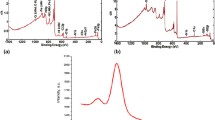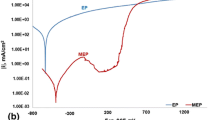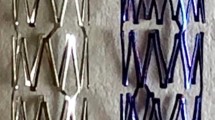Abstract
Some interesting properties such as superelasticity, shape memory effect, kink resistance, good biocompatibility, biomechanical properties, and corrosion resistance made nitinol a popular biomaterial as stent and orthopedic implants. But surface modification is needed to control nickel leaching from its surface, making safe for human body. The aim of this study was to modify the nitinol surface by the silanization technique and electrophoretically deposited hydroxyapatite coating, and to conduct a detailed in vitro and in vivo investigation. Detailed in vitro investigation involved MTT assay with the human osteoblastic cells (MG63 cell) over a period of 5 days and confocal image study. In case of in vivo study, histological study, fluorochrome labeling study, and Micro-Ct study were conducted. The overall in vitro and in vivo results indicate that silanized nitinol samples are showing slightly better level of performance, but both the surface-modified samples are suitable as the potential bio-implant for orthopedic purpose.





Similar content being viewed by others
References
C.H. Fu, P.M. Sealy, Y.B. Guo, and X.T. Wei: Austenite–martensite phase transformation of biomedical nitinol by ball burnishing. J. Mater. Process. Technol. 214, 3122 (2014).
F.L. Nie, Y.F. Zheng, Y. Cheng, S.C. Wei, and R.Z. Valiev: In vitro corrosion and cytotoxicity on microcrystalline, nanocrystalline, and amorphous NiTi alloy fabricated by high pressure torsion. Mater. Lett. 64, 983 (2010).
I. Gotman, D. Ben-David, R.E. Unger, T. Böse, E.Y. Gutmanas, and C.J. Kirkpatrick: Mesenchymal stem cell proliferation and differentiation on load-bearing trabecular nitinol scaffolds. Acta Biomater. 9, 8440 (2013).
M. Akmal, A. Raza, M.M. Khan, M.I. Khan, and M.A. Hussain: Effect of nano-hydroxyapatite reinforcement in mechanically alloyed NiTi composites for biomedical implant. Mater. Sci. Eng., C 68, 30 (2016).
S. Kamali, S. Shemshad, A. Khavandi, and S. Azari: Construction novel hydroxyapatite-nitinol nanocomposite for hard tissue applications. Mater. Chem. Phys. 220, 331 (2018).
J. Khalil-Allafi, B. Amin-Ahmadi, and M. Zare: Biocompatibility and corrosion behavior of the shape memory NiTi alloy in the physiological environments simulated with body fluids for medical applications. Mater. Sci. Eng., C 30, 1112 (2010).
S.A. Shabalovskaya, H. Tian, J.W. Anderegg, D.U. Schryvers, W.U. Carroll, and J.V. Humbeeck: The influence of surface oxides on the distribution and release of nickel from nitinol wires. Biomaterials 30, 468 (2009).
S.A. Shabalovskaya, J. Anderegg, F. Laab, P.A. Thiel, and G. Rondelli: Surface conditions of nitinol wires, tubing, and as-cast alloys. The effect of chemical etching, aging in boiling water, and heat treatment. J. Biomed. Mater. Res., Part B 65, 193 (2003).
R. Singh and N.B. Dahotre: Corrosion degradation and prevention by surface modification of biometallic materials. J. Mater. Sci.: Mater. Med. 18, 725 (2007).
F. Sun, X. Pang, and I. Zhitomirsky: Electrophoretic deposition of composite hydroxyapatite–chitosan–heparin coatings. J. Mater. Process. Technol. 209, 1597 (2009).
K. Dudek, M. Plawecki, M. Dulski, and J. Kubacki: Multifunctional layers formation on the surface of NiTi SMA during β-tricalcium phosphate deposition. Mater. Lett. 157, 295 (2015).
Y.C. Tsui, C. Doyle, and T.W. Clyne: Plasma sprayed hydroxyapatite coatings on titanium substrates. Part 2: Optimisation of coating properties. Biomaterials 19, 2031 (1998).
M.F. Hsieh, L.H. Perng, T.S. Chin, and H.G. Perng: Phase purity of sol–gel-derived hydroxyapatite ceramic. Biomaterials 22, 2601 (2001).
J. Venugopal, M.P. Prabhakaran, Y. Zhang, S. Low, A.T. Choon, and S. Ramakrishna: Biomimetic hydroxyapatite-containing composite nanofibrous substrates for bone tissue engineering. Philos. Trans. R. Soc., A 368, 2065 (2010).
F.Z. Cui, Z.S. Luo, and Q.L. Feng: Highly adhesive hydroxyapatite coatings on titanium alloy formed by ion beam assisted deposition. J. Mater. Sci.: Mater. Med. 8, 403 (1997).
M.R. Etminanfar and J. Khalil-Allafi: On the electrodeposition of Ca–P coatings on nitinol alloy: A comparison between different surface modification methods. J. Mater. Eng. Perform. 25, 466 (2016).
M. Es-Souni, M. Es-Souni, and H. Fischer-Brandies: On the properties of two binary NiTi shape memory alloys. Effects of surface finish on the corrosion behaviour and in vitro biocompatibility. Biomaterials 23, 2887 (2002).
Y. Li, T. Zhao, S. Wei, Y. Xiang, and H. Chen: Effect of Ta2O5/TiO2 thin film on mechanical properties, corrosion, and cell behavior of the NiTi alloy implanted with tantalum. Mater. Sci. Eng., C 30, 1227 (2010).
S.A. Bernard, V.K. Balla, N.M. Davies, S. Bose, and A. Bandyopadhyay: Bone cell–materials interactions and Ni ion release of anodized equiatomic NiTi alloy. Acta Biomater. 7, 1902 (2011).
H.Y. Yeh and J.C. Lin: Bioactivity and platelet adhesion study of a human thrombomodulin-immobilized nitinol surface. J. Biomater. Sci. Polym. Ed. 20, 807 (2009).
H. Yu, J. Yan, H. Ma, X. Zeng, Y. Liu, and X. Zhao: Creating poly(ethylene glycol) film on the surface of NiTi alloy by gamma irradiation. Radiat. Phys. Chem. 112, 199 (2015).
C. Zhao, S. Pandit, Y. Fu, I. Mijakovic, A. Jesorka, and J. Liu: Graphene oxide based coatings on nitinol for biomedical implant applications: Effectively promote mammalian cell growth but kill bacteria. RSC Adv. 6, 38124 (2016).
S. Simsekyilmaz, E.A. Liehn, S. Weinandy, F. Schreiber, R.T.A. Megens, W. Theelen, R. Smeets, S. Jockenhövel, T. Gries, M. Möller, D. Klee, C. Weber, and A. Zenecke: Targeting in-stent-stenosis with RGD- and CXCL1-coated mini-stents in mice. PLoS One 11, 155829 (2016).
Z. Gorgin Karaji, M. Speir, S. Dadbakhsh, J.P. Kruth, H. Weinans, A.A. Zadpoor, and S.A. Yavari: Additively manufactured and surface biofunctionalized porous nitinol. ACS Appl. Mater. Interfaces 9, 1293 (2017).
S. Sinha, H. Begam, V. Kumar, S.K. Nandi, J. Kubacki, and A. Chanda: Improved performance of the functionalized nitinol as a prospective bone implant material. J. Mater. Res. 33, 2554 (2018).
L.F. Rodella, V. Bonazza, M. Labanca, C. Lonati, and R.A. Rezzani: Review of the effects of dietary silicon intake on bone homeostasis and regeneration. J. Nutr. Health Aging 18, 820 (2014).
B.K. Devi, B. Tripathy, A. Roy, B. Lee, P.N. Kumta, S.K. Nandi, and M. Roy: In vitro biodegradation and in vivo biocompatibility of forsterite bio-ceramics: Effects of strontium substitution. ACS Biomater. Sci. Eng. 5, 530 (2019).
K.A. Hing, P.A. Revell, N. Smith, and T. Buckland: Effect of silicon level on rate, quality, and progression of bone healing within silicate-substituted porous hydroxyapatite scaffolds. Biomaterials 27, 5014 (2006).
M. Shi, Y. Zhou, J. Shao, Z. Chen, B. Song, J. Chang, C. Wu, and Y. Xiao: Stimulation of osteogenesis and angiogenesis of HBMSCs by delivering Si ions and functional drug from mesoporous silica nanospheres. Acta Biomater. 21, 178 (2015).
B.S. Kim, S.S. Yang, J.H. Yoon, and J. Lee: Enhanced bone regeneration by silicon-substituted hydroxyapatite derived from cuttlefish bone. Clin. Oral Implants Res. 28, 49 (2017).
C.T. Price, K.J. Koval, and J.R. Langford: Silicon: A review of its potential role in the prevention and treatment of postmenopausal osteoporosis. Int. J. Endocrinol. 2013, 316783 (2013).
Acknowledgments
One of the authors Sarmita Sinha would like to acknowledge the Council of Scientific and Industrial Research. The authors wish to express their thanks to the Honorable Vice-Chancellor of West Bengal University of Animal and Fishery Sciences, Kolkata, India. Authors also acknowledge Mechanical Engineering Department and School of Bio Science & Engineering, Jadavpur University, Kolkata, India, for their support to use the facilities for the experimentation. Mangal Roy would like to acknowledge technical personnel at the Central Facility, IIT-Kharagpur, for their support in µ-CT analysis.
Author information
Authors and Affiliations
Corresponding authors
Rights and permissions
About this article
Cite this article
Sinha, S., Priyadarshani, J., Devi, K.B. et al. In vivo performance analysis of silanized and coated nitinol wires in biological environment. Journal of Materials Research 35, 1262–1270 (2020). https://doi.org/10.1557/jmr.2020.101
Received:
Accepted:
Published:
Issue Date:
DOI: https://doi.org/10.1557/jmr.2020.101




